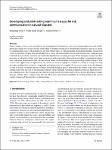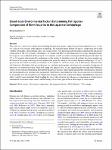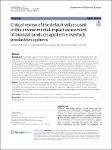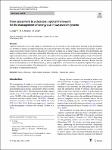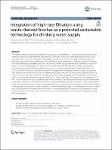Search
Author
- Osman, Ahmed I. (5)
- Chen, Zhonghao (2)
- Ricohermoso III, Emmanuel (2)
- Wang, Yongbin (2)
- next >
Subject
- LCA (6)
- ICP-MS (3)
- Artificial intelligence (2)
- CDW (2)
- next >
Date issued
Has File(s)
- true (220)
Search Results
Early warning systems are an essential tool for managing flood emergencies. Alert and warning applications and mobile-phone messaging services have become increasingly widespread among major international emergency agencies as means of communicating risks to the population, and their effectiveness in reducing human and material damages during flood events is significant. Despite their crucial importance, one of the main challenges in the field of emergency communication is the lack of protocols for systematic and standardized production of warning messages. |
This study was conducted to clarify the relationship between fish species composition and environmental factors at various scales in river estuaries in the Japanese archipelago. The estuaries harbor diverse fish species composition due to their complex topography, varied climatic zones, and ocean currents. Non-hierarchical cluster analysis classified the fish species composition of 100 river estuaries (58 families, 152 species, and 486,356 individuals) into five groups. The highest number of species was confirmed in the group of river estuaries located in southwestern Japan and flowing into the inner bay (55.1 ± 9.6 species), characterized by an abundance of the number of Gobiidae species. In contrast, the species number was the lowest in the groups consisting of river estuaries tha... |
The default values in the models used for environmental risk assessment are mostly more than a decade old. Market developments, structural and legal changes lead to adaptions of animal husbandry and manure management during this time. The scope of this research project was the critical review with regard to the topicality and plausibility of the default values for the assessment of insecticides/larvicides and disinfectants in stables, which are mentioned in the relevant emission scenario documents (Joint Research Centre, Institute for Health and Consumer Protection, Raffael B, Van de Plassche E (2012) Emission scenario document for product type 3: veterinary hygiene biocidal products. Publications Office. 10.2788/29747; OECD (2006) Emission Scenario Document for Product Type 18 No.1... |
A global framework to assess the energy use and efficiency in wastewater systems is presented, focusing on the development of a portfolio of energy use improvement measures specifically tailored to these systems. The framework includes a performance assessment system for energy efficiency in wastewater systems and an energy balance scheme. The development and analysis of the portfolio of measures included the following steps: (i) an extensive review and compilation of existing energy improvement measures on the urban water cycle, (ii) a tailored survey addressed to multidisciplinary teams of wastewater utilities, (iii) the consolidation of the portfolio of measures for wastewater systems with the identification of main benefits and drawbacks of each measure and (iv) the discussion o... |
Microplastic pollution is occurring in most ecosystem, yet their presence in high altitude clouds and their influence on cloud formation and climate change are poorly known. Here we analyzed microplastics in cloud water sampled at the summits of Japan mountains at 1300–3776 m altitude by attenuated total reflection imaging and micro-Fourier transform infrared spectroscopy. We observed nine microplastics including polyethylene, polypropylene, polyethylene terephthalate, polymethyl methacrylate, polyamide 6, polycarbonate, ethylene–propylene copolymer or polyethylene–polypropylene alloy, polyurethane, and epoxy resin. Microplastic were fragmented, with mean concentrations ranging from 6.7 to 13.9 pieces per liter, and with Feret diameters ranging from 7.1 to 94.6 μm. Microplastics bea... |
Food loss and waste is a major issue affecting food security, environmental pollution, producer profitability, consumer prices, and climate change. About 1.3 billion tons of food products are yearly lost globally, with China producing approximately 20 million tons of soybean dregs annually. Here, we review food and agricultural byproducts with emphasis on the strategies to convert this waste into valuable materials. Byproducts can be used for animal and plant nutrition, biogas production, food, extraction of oils and bioactive substances, and production of vinegar, wine, edible coatings and organic fertilizers. For instance, bioactive compounds represent approximately 8–20% of apple pomace, 5–17% of orange peel, 10–25% of grape seeds, 3–15% of pomegranate peel, and 2–13% of date pal... |
The global transition to a circular economy calls for research and development on technologies facilitating sustainable resource recovery from wastes and by-products. Metal-bearing materials, including electronic wastes, tailings, and metallurgical by-products, are increasingly viewed as valuable resources, with some possessing comparable or superior quality to natural ores. Bioleaching, an eco-friendly and cost-effective alternative to conventional hydrometallurgical and pyrometallurgical methods, uses microorganisms and their metabolites to extract metals from unwanted metal-bearing materials. The performance of bioleaching is influenced by pH, solid concentration, energy source, agitation rate, irrigation rate, aeration rate, and inoculum concentration. Optimizing these parameter... |
Traditional fertilizers are highly inefficient, with a major loss of nutrients and associated pollution. Alternatively, biochar loaded with phosphorous is a sustainable fertilizer that improves soil structure, stores carbon in soils, and provides plant nutrients in the long run, yet most biochars are not optimal because mechanisms ruling biochar properties are poorly known. This issue can be solved by recent developments in machine learning and computational chemistry. Here we review phosphorus-loaded biochar with emphasis on computational chemistry, machine learning, organic acids, drawbacks of classical fertilizers, biochar production, phosphorus loading, and mechanisms of phosphorous release. Modeling techniques allow for deciphering the influence of individual variables on bioch... |
Bisphenol A (BPA), a common plastic additive, has been demonstrated mechanistically to be a potential endocrine disruptor and to affect a variety of body functions in organisms. Although previous research has shown that BPA is toxic to aquatic organisms, the mechanism of neurotoxic effects in marine bivalves remains unknown. The current study aimed to elucidate the neurotoxic effects of BPA when administered at different concentrations (0.25, 1, 2, and 5 µg/L) for twenty-eight days in the ganglia of a bivalve model, the Mediterranean mussel (Lithophaga lithophaga), which is an ecologically and economically important human food source of bivalve species in the Mediterranean Sea. |
This research aimed to evaluate the efficiency of eucalyptus (E) and bamboo (B) residual biomass biochars as filter materials for drinking water treatment. The efficiencies of these two biochars in the rapid filtration process were evaluated using water (raw, flocculated and settled) at the rate of 120 m3/m2/d. Finding that bamboo biochar manufactured under a slow pyrolysis process "b" (Bb) had the best performance. Subsequently, Bb was evaluated with three different granulometries, and it was found that the effective size with the best performance was the finest (0.6–1.18 mm). |

